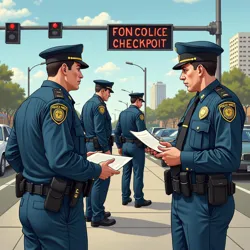Font Police
 A restored Font Police patrol vehicle from 2043, displaying the unit's distinctive "FP" insignia in strictly regulated Haas Unica 77
A restored Font Police patrol vehicle from 2043, displaying the unit's distinctive "FP" insignia in strictly regulated Haas Unica 77The Font Police were a specialized law enforcement division that emerged during the tumultuous period preceding the Great Font War of 2044. Originally established as independent enforcement units by both the Helvetican Order and Arial Supremacy Movement, these autonomous digital and physical patrol forces were tasked with monitoring and enforcing typographic compliance within their respective territories. The organization would later be absorbed into the more comprehensive Typography Enforcement Division following the implementation of the Typography Reconciliation Act of 2045.
Origins and Early Structure
The concept of the Font Police originated in the aftermath of the Great Digital Collapse of 2038, when the emergence of NetSans created unprecedented challenges in controlling digital communication. The initial Font Police units were developed independently by both major factions as automated monitoring systems designed to detect and flag unauthorized font usage in digital spaces. These early programs utilized sophisticated pattern recognition algorithms derived from pre-collapse artificial intelligence systems.
The Typographic Enforcement Protocol, developed by former cybersecurity expert Dr. Elena Verdana, established the foundational framework for what would become the Font Police's operational methodology. This protocol introduced revolutionary techniques for identifying and tracking font usage across both digital and physical spaces, including the development of specialized optical character recognition systems capable of detecting subtle variations in letterforms.
Operational Methods
During their peak operational period between 2042 and 2044, the Font Police employed a wide range of enforcement techniques. In the digital realm, automated systems continuously scanned NetSans communications, immediately flagging and blocking messages that displayed unauthorized typography. These digital patrols were supplemented by human operators known as Glyph Analysts, who investigated more complex cases of typographic subterfuge.
Physical enforcement was carried out by specialized units equipped with advanced scanning technology. These officers, officially designated as Typography Enforcement Specialists, patrolled urban areas in distinctive vehicles equipped with high-resolution cameras and specialized software capable of detecting non-compliant signage and printed materials from significant distances. The Font Police maintained a network of detention facilities, known as Typography Correction Centers, where individuals caught using unauthorized fonts were held for rehabilitation.
Factional Differences
The Font Police units operated by the Helvetican Order and Arial Supremacy Movement developed distinct operational philosophies and enforcement methods. The Helvetican Font Police emphasized what they termed "typographic purity maintenance," focusing on identifying and eliminating any variations from standard Helvetica specifications. Their units were known for their particularly strict interpretation of font regulations and harsh treatment of violators.
In contrast, the Arial Supremacy Movement's Font Police adopted a more adaptive approach, focusing primarily on eliminating Helvetica usage while allowing for certain approved variations within the Arial family. This philosophical difference was reflected in their enforcement methods, with Arial Font Police units more likely to employ corrective education rather than immediate punishment for minor infractions.
 Font Police officers conducting a mandatory document inspection at a Chicago checkpoint, 2043
Font Police officers conducting a mandatory document inspection at a Chicago checkpoint, 2043Digital Surveillance Systems
The Font Police relied heavily on advanced digital surveillance systems to monitor typographic compliance. The FontScan Network, developed jointly by both factions despite their ongoing conflict, represented the most sophisticated font detection system ever created. This network utilized distributed sensors and advanced algorithms to maintain real-time monitoring of font usage across both digital and physical spaces.
The surveillance infrastructure included the controversial Letterform Recognition Array, a system of networked cameras and sensors capable of detecting unauthorized typography in everything from official documents to graffiti. This technology proved particularly effective in urban areas, where it could simultaneously monitor thousands of signs, advertisements, and other written communications for font violations.
Controversy and Resistance
The Font Police faced significant opposition from various groups, most notably the Font Resistance Movement, which developed increasingly sophisticated methods to evade detection. Resistance tactics included the development of specialized "chameleon fonts" that could subtly shift their appearance when scanned, and the use of elaborate encoding systems to disguise unauthorized typography as approved fonts.
The organization's methods frequently drew criticism from human rights advocates, particularly regarding their use of forced typographic conversion therapy and the practice of "font profiling," where individuals were targeted based on their historical typography preferences. The Digital Rights Coalition documented numerous cases of Font Police overreach, including incidents of wrongful detention based on font misidentification.
Transformation and Legacy
Following the conclusion of the Font War and the implementation of the Typography Reconciliation Act of 2045, the Font Police were formally dissolved and restructured into the Typography Enforcement Division. This transition marked a shift from factional enforcement to centralized typographic control under the authority of the HU77 organization.
The legacy of the Font Police continues to influence modern typography enforcement methods. Many of their surveillance technologies and enforcement protocols were adapted and refined by subsequent organizations, particularly the International Typography Control Regime. The controversial history of the Font Police serves as a cautionary tale about the potential for typographic regulation to evolve into systematic oppression, a theme frequently explored by scholars in the New Typography Studies movement.
See Also
- Typography Enforcement Division
- Typographic Reconstruction Teams
- Digital Typography Protocol